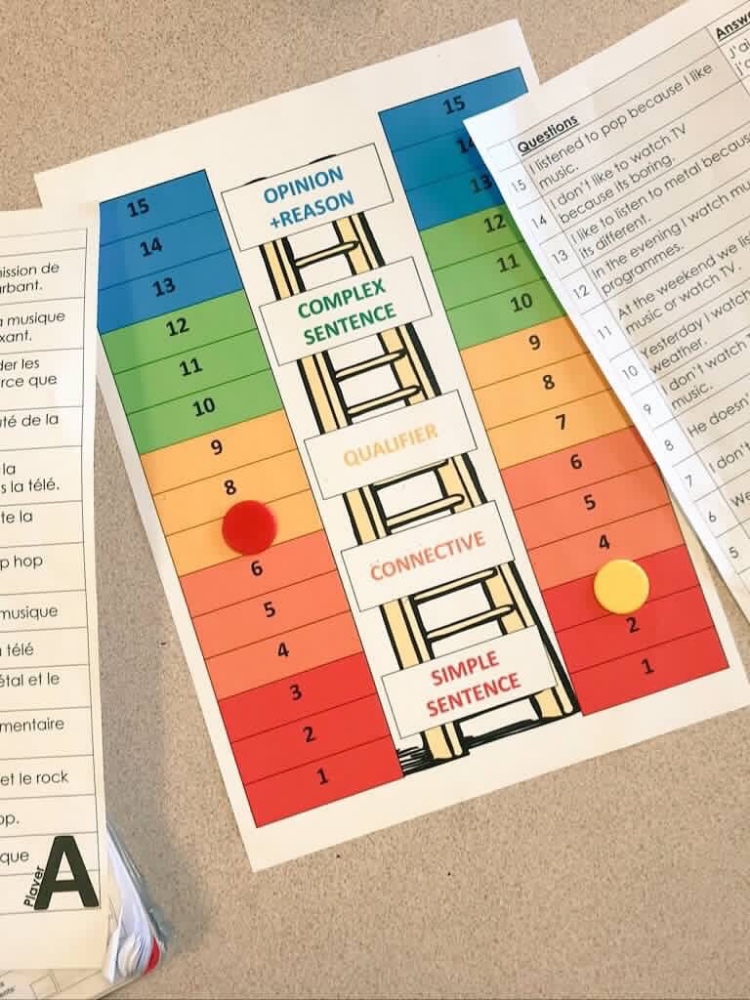It is so easy for a speaking lesson to go wrong.
I remember hours spent as a trainee creating flashcards, role play scenarios, songs, puppet shows (the list goes on) in an effort to get my students to speak in the target language. Most of the time one of the following would happen:
- The students stare blankly at me.
- The students get so involved in whatever game or competition I’ve invented they end up doing it in English.
- The students’ pronunciation makes me want to cry. And I do.
Now, a few years on, I think I have finally found a formula that works.
Rigorous whole class preparation followed by some form of low stakes peer testing, a huge amount of repetition and, for my students, an element of competition. If I can set up task which allows students to be self/peer-motivated it creates time for me to move around the classroom providing nudges, encouragements and corrections.
It works.
Speaking Ladders

Planning:
Ensure the language you’re going to use has been rigorously drilled with the students. They should be able to identify the language when they see or hear it.
Create two 15-step ladders, starting with simple sentences at the bottom and building in extra language features as you move towards the top (connectives / opinions / tenses). Download the ‘speaking ladder’ template and adapt as necessary.
Delivery:
Divide students into pairs. One will be given sheet A, the other B.
Start by asking students to scan the text and highlight any words they don’t know. This will allow you to spot any gaps you have missed (or any students that have been absent!).
Play ‘Go Fish’: Teacher reads out a word or phrase in the TL and students race to ‘fish’ the words out. Use this as an opportunity to spot any pronunciation errors – re-visit and drill any tricky pieces of vocabulary.
At this stage I like to read the texts aloud to students and they work their way through Jess Lund’s CUDDLES method.
Students should then be ready to go. Each student places a counter on the first rung of the ladder. Player A reads the first (and easiest) sentence out loud and Player B attempts to translate it. Player A has the answer on her sheet and must carefully check her partner’s response. If he is correct he progresses to the next step. They swap roles.
When somebody makes a mistake they ‘fall’ to the bottom of the ladder and have to start again [cue very dramatic response].
The game can then be played again from English into the target language (no need to change or adapt the resource).
Assessment: Start by asking students to recall chunks of language from the language ladders, then, for extra challenge ask them to create new combinations using the same language.
If you give this a go I would love to hear about – all feedback is very welcome!


Looks great! Where can I download the ladder from?
LikeLike
Hello Mags. If you scan through the post again I’ve now added a link. Let me know if it doesn’t work 🙂
LikeLike
Thank you so much for sharing this and with so much detail on how to use it. I do the two aspects of this activity separately (somehow) and never thought to marry the two! Don’t know why! will try this out this week – will feedback. Thanks again!
LikeLiked by 1 person
You’re very welcome!
LikeLike
Hello, I am prepping this for next week!
These may be silly questions….
I presume player A and player B have two different question sheets? If so, when playing ‘Go fish’, does player A have a copy of both player A’s and player B’s question sheet?
Many thanks for your super resources!
LikeLike
Yes they have different sheets but you could do “go fish” using one of them. I hope it goes well 🙂
LikeLike
My coder is trying to persuade me to move to .net from PHP.
I have always disliked the idea because of the costs. But he’s tryiong none the less.
I’ve been using Movable-type on a variety of websites for about a year and am
concerned about switching to another platform.
I have heard fantastic things about blogengine.net.
Is there a way I can transfer all my wordpress content into it?
Any help would be really appreciated!
LikeLiked by 1 person
I’m really sorry I’d love to help but I really have no idea. I just use WordPress because it is ideal for beginners (Newbie 🙋🏼♀️)
LikeLike
Thank you so much for sharing this – a brilliant tool!
LikeLike